Learn how to grow and use horseradish roots and enjoy this spicy culinary vegetable’s health benefits in your garden and kitchen. Horseradish is a traditional dish for Passover, and is also a valuable ingredient in Fire Cider.
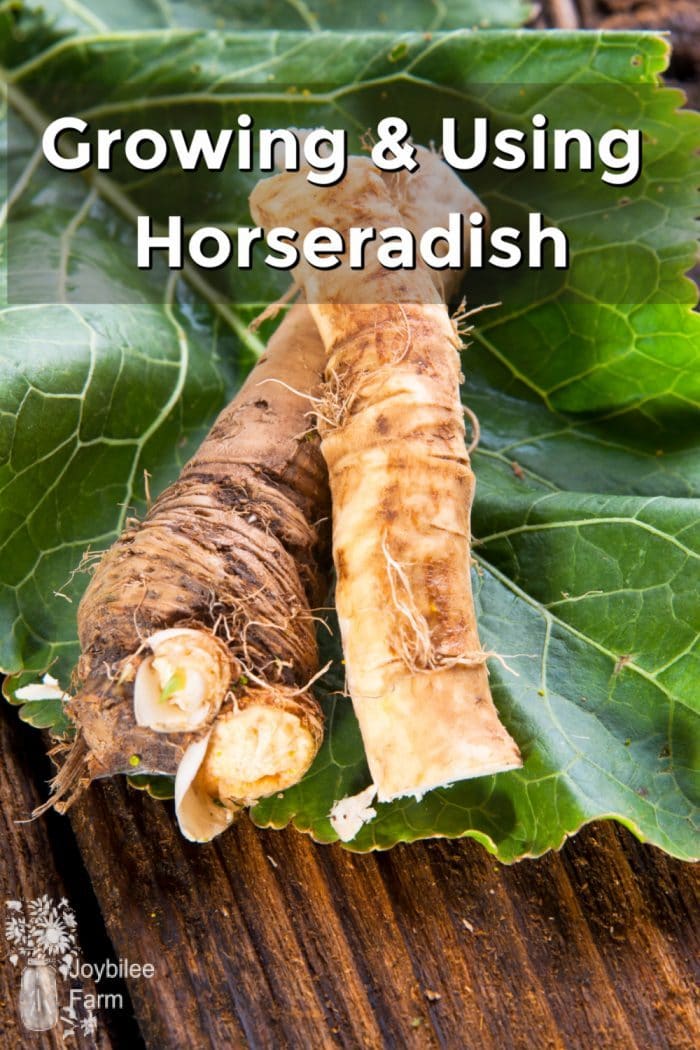
I nibbled a horseradish leaf yesterday. It started innocently enough. There really isn’t that much up in my garden, it being just the middle of April. 2 weeks ago my garden was still covered with snow. But this week we’ve had some warm 70°F weather, and the dandelion greens and rhubarb are vibrant. The curly, feathering leaves of horseradish were just starting to unfurl. And so I nibbled.
I was expecting a brain clearing blow of spicy heat. I even waited for it, like you do when you bite a raw jalapeno. But it didn’t come. Instead I tasted kale. No heat. Just sweet mild kale-like flavour. That makes sense since horseradish is from the brassica family, like kale, cabbage, woad, and spring radishes, all lovely and mild in the early spring, if you happen to find them overwintered.
It’s a little deceptive don’t you think? Sort of like peeling and chopping those horseradish roots, in their ivory innocence. There is no hint of the volatile oils hidden in the plant cells. The uninitiated processing horseradish for the first time may wonder what the big deal is all about. And then it hits you, full in the face, like a sucker punch.
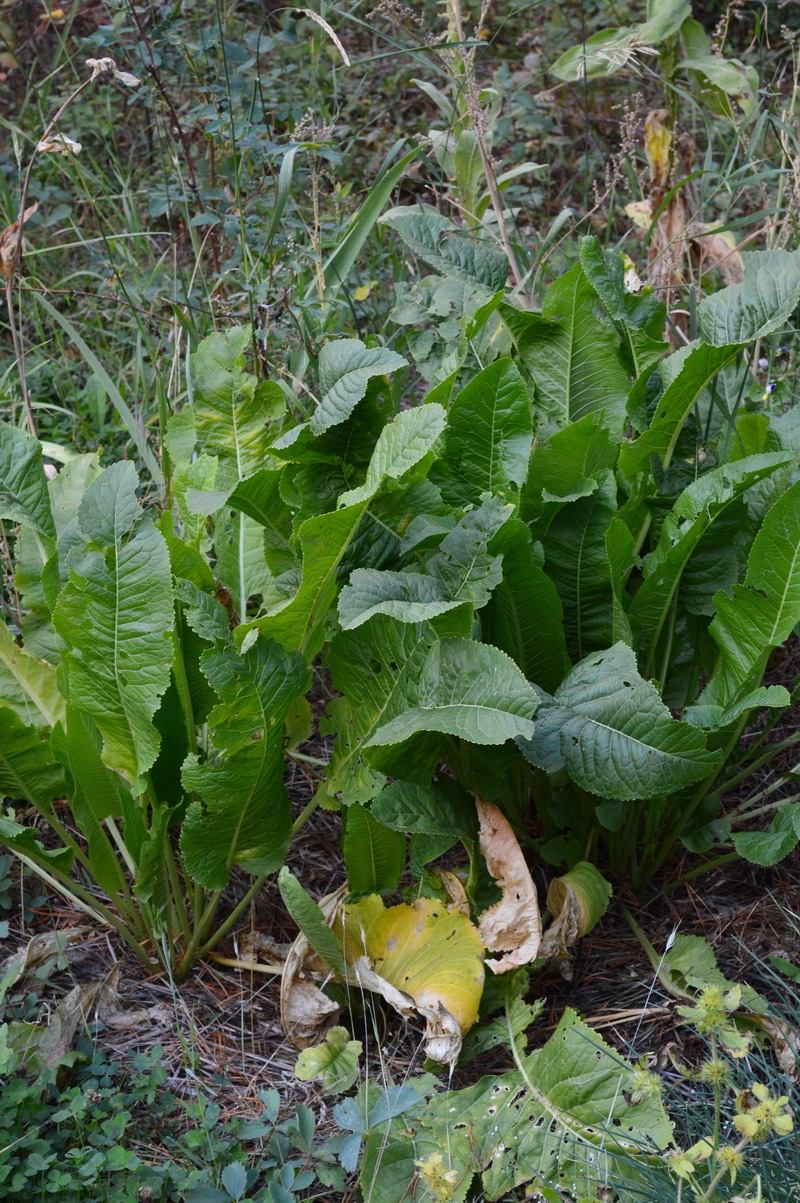
Horseradish in August
How to Grow Horseradish
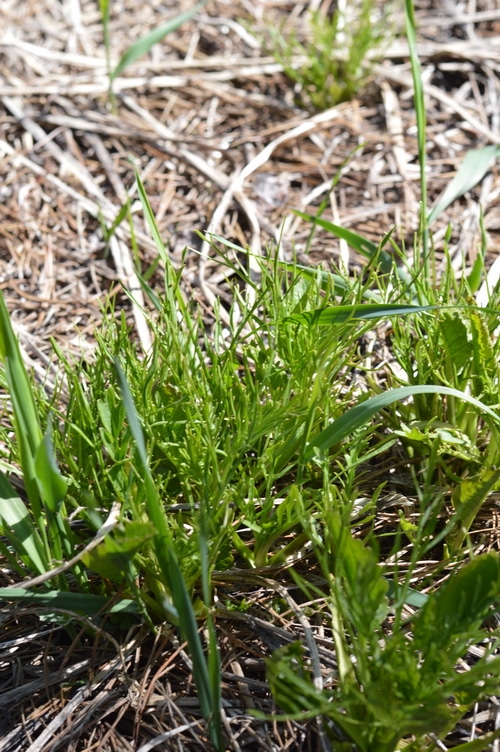
Horseradish in early spring. Notice the feathery leaves that are very different than the normal summer leaves.
Horseradish (Armoracia rusticana) is an easy to grow perennial herb that is hardy to zone 3. It is a vigorous grower that likes rich soil. It isn’t bothered by insect or fungal diseases. A large plant will spring from the smallest root. It grows to about 2 1/2 to 3 feet high in rich, moist soil, with deep roots that bring up minerals from deep within the subsoil. Put horseradish in a corner of the garden where it can spread, and where it won’t shade out other plants.
Horseradish spreads by underground runners so your one plant will create baby plants all around it in its second spring. Roots harvested at the end of the first year will be small but flavourful. Wait until the third year after planting before you begin to harvest roots regularly. A well established horseradish plot can be harvested all season long.
Horseradish rarely produces seed, so you’ll need to start your plants with root divisions. Beg a start from your neighbor or plant some grocery store horseradish that’s in good shape. The starts should be plump, with no signs of mold or decay.
Prepare the ground with seasoned compost and loosen the soil with a spade, at least two feet deep, to allow the roots to grow straight and unhindered.
Companion planting
Horseradish is a companion plant to potatoes and fruit trees. Its strong scent discourages pests, while its deep roots bring up minerals from the subsoil, for surrounding plants. After the initial spring greens feast of mild tasting leaves, horseradish leaves become tough and acrid. You can use them as a chop and drop mulch for potatoes to discourage potato beetles, slugs, and other pests.
Don’t plant near grapes or vines. Culpepper reports that grapes shun horseradish when vines and horseradish are planted near each other.
Horseradish roots can be harvested on an as needed basis throughout the growing season after their 2nd winter. Alternatively, in the October of the second year, harvest all the roots at once. Replenish the bed with fresh composted manure and replant several roots in the renewed horseradish bed. Then mulch with a 4 to 6 inch layer of straw or leaves for the winter. In colder areas, where winter temperatures drop below -40F/-40C, roots can be kept in damp sand over the winter, in a root cellar, and replanted in spring.
It’s better to use the roots fresh as needed in the kitchen, rather than trying to process a large batch of horseradish for canning. When heated, this root loses its pungency and becomes mild like turnips and rutabagas.
Horseradish roots, kept in damp sand over winter, can be forced to produce fresh, vitamin C rich, greens in winter. When you see the roots sprouting green leaves, expose the tops of the plants to daylight. You’ll be able to harvest the green tops in two or three weeks.
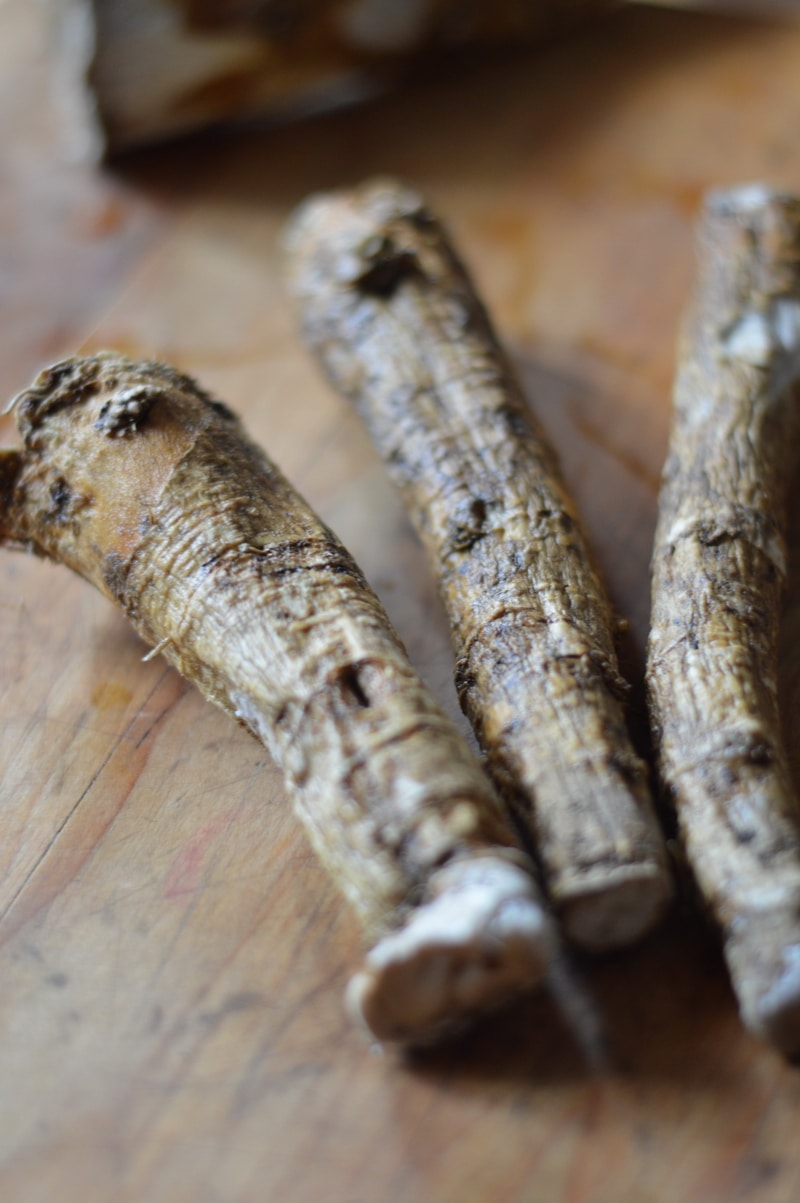
A little history
I read in Amy Bess Miller’s Shaker Medicinal Herbs, a compendium of history, lore, and uses that horseradish leaves are high in vitamin C and used to treat scurvy. In fact horseradish has been used medicinally since ancient Greece. It’s only been used as a condiment in the last three centuries, as an accompaniment to fatty red meats and fatty fish.
The leaf is used as a spring green with its mild, kale-like flavour. The leaves don’t get spicy till the weather warms up. The root is spicy in spring though. It makes a good remedy for spring sinus congestion, but it is also a welcome addition to the Passover table.
Horseradish for Passover
In Ashkenazi Jewish tradition, horseradish root is prepared as one of the bitter herbs of the Passover Seder plate. To prepare horseradish for a traditional Seder plate, it’s important that the horseradish brings tears to the eyes, as a reminder of the bitterness of slavery.
While the addition of an acid like vinegar, lemon juice, or even kombucha will cut the heat of horseradish, for the Seder plate itself, the horseradish is prepared with just a bit of salt and water. Or salt and whey (for a dairy meal) to preserve it with probiotics.
As an accompaniment to the Passover meal, horseradish can be prepared with beets, called Chrain. See my recipe for mild red horseradish sauce with kombucha vinegar on the Fermentools blog. With this recipe you control the heat by the timing of when you add the kombucha. Add it as soon as you put the horseradish in the food processor for a mild condiment (um, mild is relative when it comes to horseradish) or wait up to 30 minutes after processing to add it, for a blow-up-your-sinuses condiment. The choice is yours. Grab my recipe for Chrain here.
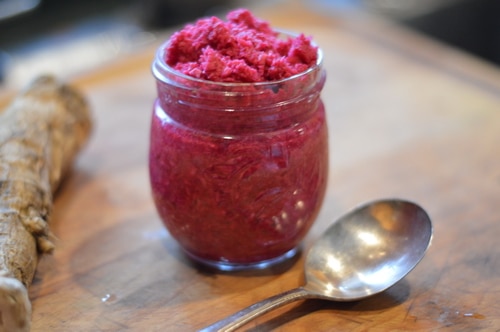
Fresh Horseradish for the Passover Seder
However, for the kosher seder plate red horseradish should never be used. Instead probiotic horseradish prepared with whey (dairy meal) or vegetable culture is preferred. You’ll want to make this a few days before the Seder so that it has a bit of probiotics to help with digestion. But if you waited till the day of, no problem. Just proceed with the recipe when you need it. The addition of culture gives it a bit longer shelf life in the fridge.
You’ll only need a small portion – enough for each person to eat about 1 tsp at the Seder table, a bit on the matzah and then a bit for the Hillel sandwich with charoseth. 4 ounces or ½ cup (125ml) of prepared horseradish is enough for 12 adults for the Seder Haggadah ceremony. You’ll need a little less for children.
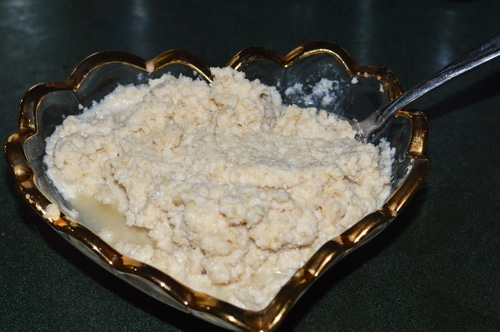
Pungent Probiotic Horseradish for Passover
This recipe makes ½ cup of prepared probiotic horseradish. This is very pungent with no acid to quench the fire. You can double the recipe if you will have more people at your Passover Seder. Preparation time about 10 minutes. Use a food processor and open the food processor outside, so that the volatile oils can dissipate outside.
Ingredients:
2 tbsp. starter culture for fermented vegetables (or whey if your meal is a dairy meal)
1 6 inch horseradish root, peeled and chopped
½ tsp. salt
*Cold water
Method:
Peel and chop the horseradish root into ½ inch slices. Put on your onion goggles on and proceed in a well-ventilated space. Put the horseradish root, whey, and salt, into your food processor. Process on high for 30 seconds. Add *cold water 1 tbsp. at a time, if necessary, to allow the blades to process the horseradish root freely.
When the horseradish root is pureed fully, transfer the prepared horseradish root to a jar and refrigerate. The lacto-bacteria in the whey will preserve the horseradish for several weeks, if kept refrigerated.
Medicinal Benefits of Horseradish
Horseradish used to be used a lot more in herbal medicine than it is today. It is stimulant, carminative, digestive, rubefacient, mildly laxative, diuretic, hepatic, antiseptic, vulnerary, circulatory, emmenagogue, expectorant, vermifuge, counterirritant, immunostimulant, antioxidant, antitumor, and antimicrobial.
The volatile oils and sulfur compounds in horseradish give it its heat and its strong medicine. For a complete Materia Medica on Horseradish see my article in the Spring 2016 Issue of The Biblical Herbal, “Bitter Herbs of Passover: Horseradish”. When you subscribe you’ll also get my recipe for Prepared Horseradish.
A word about The Biblical Herbal Magazine
The Biblical Herbal Magazine is a group project that I’m part of with several other Christian and Messianic Herbalists. Published by Tamra Speakman of Shatul Wellness, our goal is to restore the knowledge of healing herbs that are gifts of the Creator. Each issue will focus on an aspect of the Biblical year and the Feasts of the Lord.
The Spring issue, our inaugural issue is focused on restoration, deliverance, and the Spring Feasts of the Lord. This is a quarterly journal which we hope will bring you wellness that is deeply rooted in the Word of God.
The magazine is suitable for those who are looking for advanced information on the use of herbs in the home and in the community, along with biblical teaching to nurture you in both herbs and the scriptures. There are recipes and even a section for the children. We hope it will bless you.

Prepared Horseradish 3 ways
So there you have it. Prepared horseradish 3 ways, hot and spicy for the Passover Seder (this recipe), a little more mild but still suitable for the Passover table. My mild beet and horseradish sauce is delicious with Gefilte Fish, salmon, lamb, and roast beef. It won’t have eyes watering that severely if included in the Passover Seder, either. Serve it as a side to fatty foods. Not only does it taste good, it’s a helpful digestive, too.
Oh, and it’s even delicious stirred into lamb stew, chili, or even butter chicken just before serving. It’s that secret ingredient that makes a weekday meal just a little extra special.
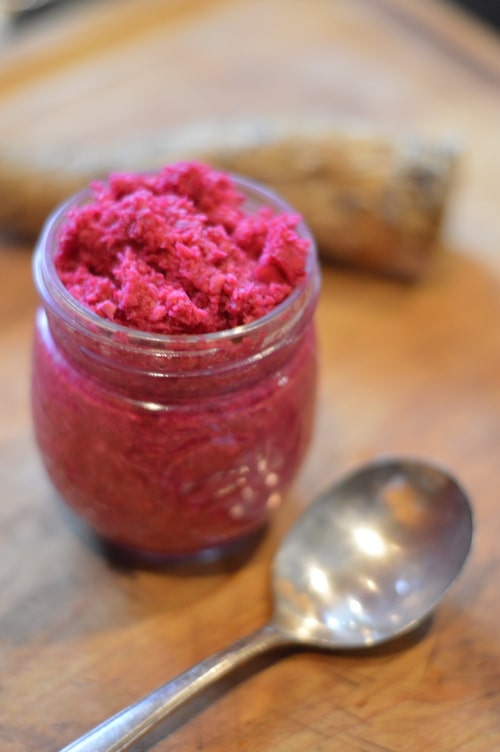
Your turn:
Do you like your horseradish searing hot, medium, or mild with a little colour?


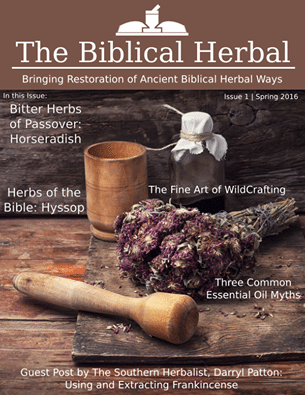


Only in a digital subscription.
Perhaps it’s not there anymore. I couldn’t get the page to load today for the Biblical Herbal Magazine. But it could also be my internet issue. I’ll have to try again later.